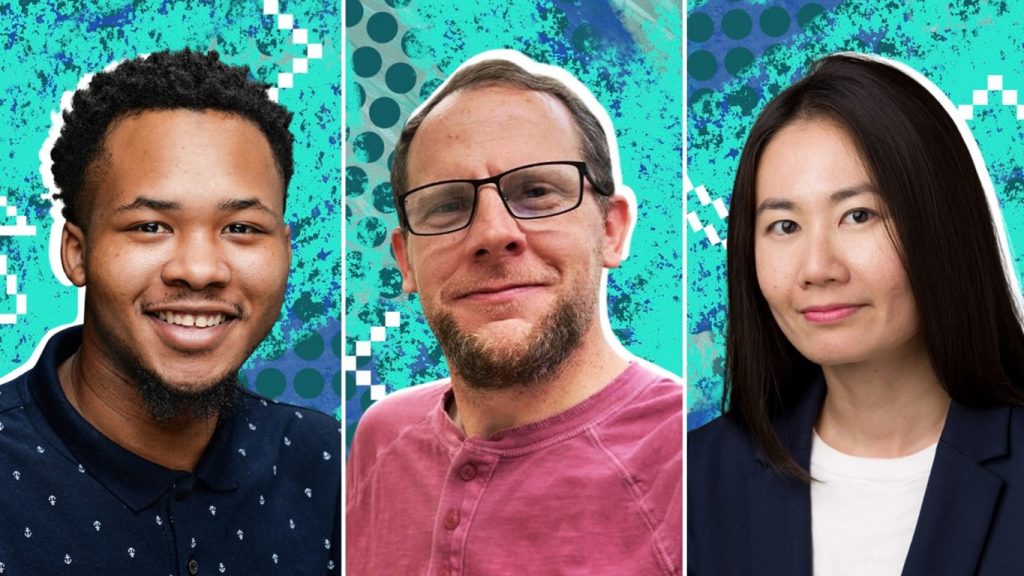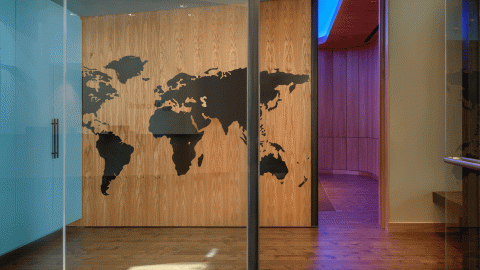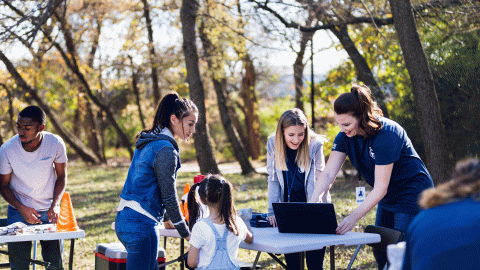How a community in Southern Virginia is helping locals develop digital skills
“Most people don’t think of ‘South Boston, Virginia,’ when it comes to technology, but it’s there,” says Darryl Kent.
Kent is a native of South Boston, Va., population 7,500, in the southern part of the state. It’s just after noon, and he’s on his lunch break, talking on video chat about his responsibilities working for an outdoor furniture company based there. The shelves behind him are lined with PC towers awaiting maintenance; he’ll run diagnostics on them to get them back into service.
Amid the flashing lights, the whir of the machines and the fans cooling them, Kent will open his laptop to check the cameras and the doors of the facility. He’ll then call up a list of new hires and departures and get to work updating their access privileges in the company’s system.
“If it involves technology,” Kent says, “I have my hands on it.”
Manufacturing is a big industry in South Boston, where it’s a 50-mile drive to the nearest big city. But luxury outdoor furniture brands in remote areas need information technology (IT) expertise to function in today’s increasingly digital economy.
Kent says he had known his entire life that he wanted a career in IT. As a kid he threw himself into anything that involved technology, including robotics, audiovisual editing classes and extracurriculars. Later, he moved 160 miles east, across the state, to study computer science at Old Dominion University in Norfolk. Three years into the program, he had to return home to South Boston where he enrolled at the IT Academy at Southern Virginia Higher Education Center (SVHEC). In early 2021, he got a job as a help desk analyst for his current employer, which has offices around the world. And he continues to draw on his experience from the academy today. “I’ve had many a time where I’ve just been hit with a random problem,” says Kent. “And that hands-on knowledge from the academy is something that I can always look back to and immediately grasp onto.”
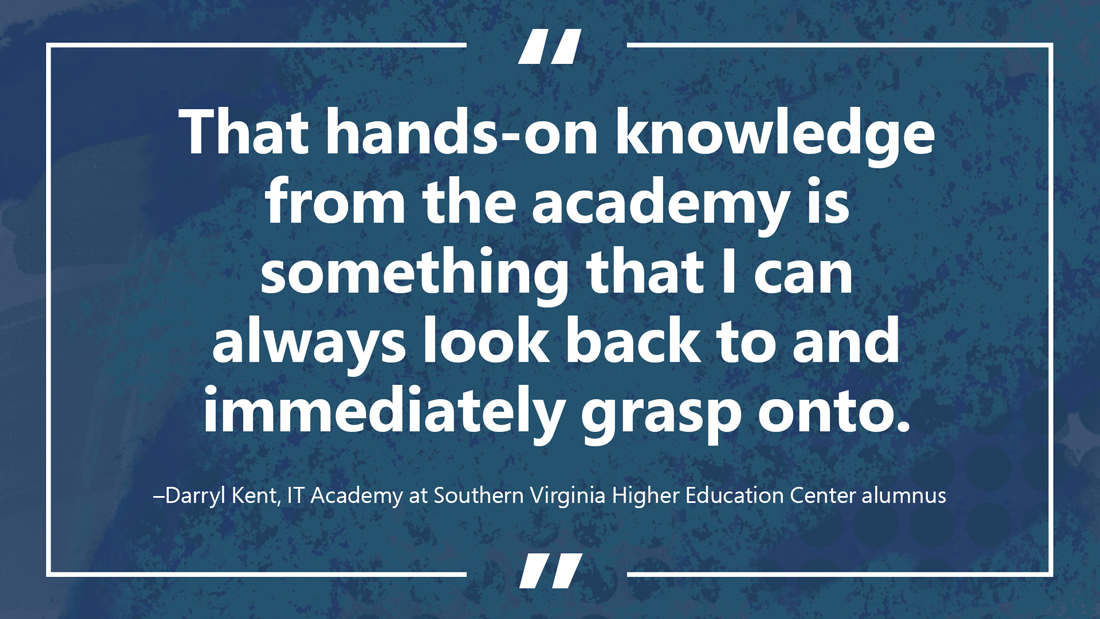
The IT Academy at SVHEC was created in 2015, with support from technology firms working in the area, including Microsoft. Offering affordable practical training and professional IT certification, it has since helped 314 people train for jobs requiring IT skills. Nearly 90% of students secure a job within 12 months of completing the program, and many go on to well-paying roles in technology.
Fostering essential digital skills
Across the U.S., about 41 million people live in areas 25 miles or more from the nearest college or university, according to estimates from the Urban Institute, a Washington, D.C.-based think tank. Many of these places are in rural regions, where lack of transportation options, access to broadband and childcare difficulties are among the factors that prevent people from furthering their studies. In turn, a less educated workforce makes it harder for these communities to attract businesses and create new jobs.
In the late 1990s and early 2000s, Southern Virginia was hit by the closures of multiple factories, textile plants and tobacco farms. But now new skills are in high demand. In 2010, Microsoft opened a datacenter – a facility that stores, manages and distributes the data the world sends to the cloud – in Boydton, a town about 30 miles from South Boston. For the first few years, employees were commuting distances of about 90 miles from cities such as Richmond or Raleigh, North Carolina.
Today, the IT Academy at SVHEC is building these technical skills among local residents, providing short-term training for A+ and Server+ certifications from the Computing Technology Industry Association (CompTIA). These are considered essential for entry-level positions such as IT technician or datacenter technician. Students can also advance to other classes, including Network+, which covers troubleshooting, configuring and managing networks to help students develop careers in tech infrastructure.
It’s not all about datacenters though. Industries in Southern Virginia include advanced manufacturing, education and health care, and IT skills are growing in importance. Opening people’s eyes to the different career paths technology offers is a focus for Microsoft TechSpark, a civic program that, since 2017, has been collaborating with nonprofits, schools and local enterprises to foster economic opportunity and job creation across the U.S.
In Southern Virginia, TechSpark also works alongside the Microsoft Datacenter Community Development initiative, which brings training opportunities and hands-on experiences to the IT Academy program, as well as to a similar program at Southside Virginia Community College in South Hill – also close to the Boydton datacenter.
“All of the industries that are present here are going to be present, we hope, 20, 30, 40 years down the road,” says Jeremy Satterfield, manager, TechSpark Virginia. “And technology is becoming a more integral piece of that each and every year. We’re trying to help folks understand that and look at learning as a lifelong commitment.”
This outlook is shared by Kent, who says he is always looking for opportunities to reinforce his skills. He left the IT Academy with the courses he needed to secure a job in IT. He credits the practical training he received at the IT Academy with giving him the skills to take on anything his job throws at him. “Every bit of information I received at the IT Academy has honestly helped me to make this place better,” he says.
A classroom datacenter
The old red-brick tobacco warehouses that are home to SVHEC and its IT Academy are probably not where one would expect to find the blinking lights and rows of servers typical of a modern datacenter. In fact, these historic buildings house a workspace that’s as close to a fully functioning datacenter as you’re likely to find in a classroom environment. It is vital to the practical training that makes up about 50% of students’ time at the academy.
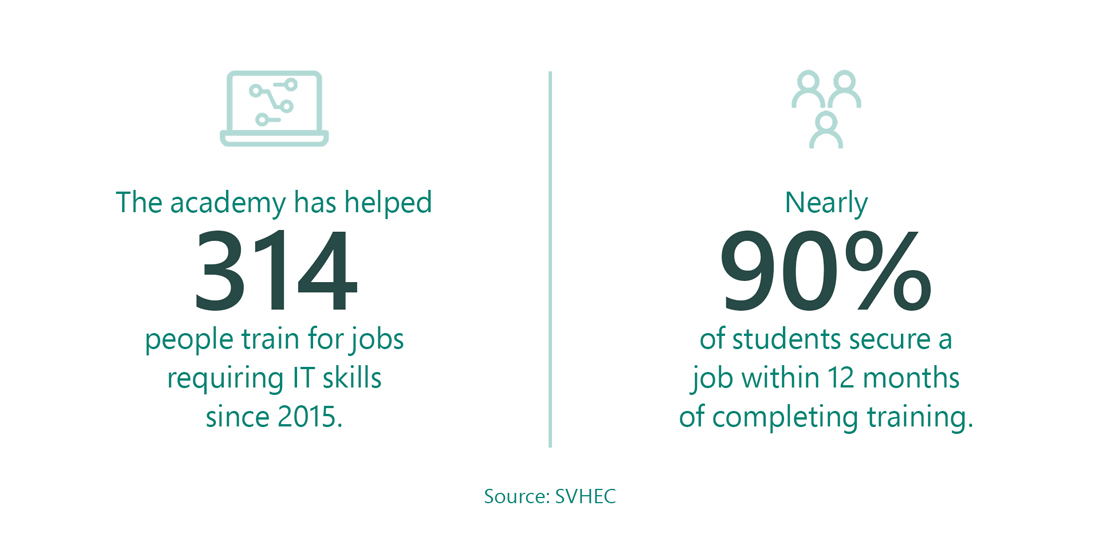
The way that the server cabinets are labeled, using the hot aisle, cold aisle server layout – common in datacenters to help increase the effectiveness of the cooling system. Even fingerprint scanners to recreate the feel of a secure environment are in place. Microsoft donates such equipment through the Datacenter Academy, a workforce development initiative, including recently a $25,000 network tester that allows students to train on the exact kit used by technicians at the Boydton datacenter.
Training in this environment sets the institution’s graduates apart. Kelly Shotwell, director at the IT Academy, says it leads to quicker onboarding. “I have gotten feedback from datacenter staff that our students are easier to train,” she says. “They learn how to pull a server out of a cabinet; they understand what a rack-mount server is versus a blade server. And they’ve handled both of them. They get a feel for how to work with that equipment.”
Getting hands-on with IT training
Matthew Rulli is another former student of the IT Academy. He relocated to Southern Virginia in 2015 from his native New Jersey with his wife and children.
As a 20-year veteran of the construction industry, he found there wasn’t as much call for his skills as there had been in the Garden State. “I was the main support for my family,” he says. “So, I had to find something quickly and still come out of it and make decent money.”
Rulli homed in on an interest that had always been at the back of his mind: technology. This took him to the IT Academy, where through A+, Server+ and Network+ classes he gained the skills needed to configure and manage servers and networks. Just a few months after completing his course, he secured an IT job at a local school system, where he was recently promoted to system administrator.
“It all started with the IT Academy,” he says. And he calls out the practical side of the courses, which first introduced him to a datacenter environment, as being perfectly aligned with how he learns best. “I’ve built houses from the ground up. And when you’re building a house, it’s similar to a computer: There are so many systems that have to tie together. That’s where I learn the most – when I’m actually doing something. It’s gotten me to where I am today, and I’m very thankful for it.”
From networks to networking
Tina Jang relocated from Taipei, Taiwan, to the Southern Virginia town of Virgilina in 2018 with her husband to be closer to his family. Like Rulli, she saw the opportunity for something new.
She earned a Microsoft Datacenter Academy scholarship, which pays for 100% of IT education costs for individuals from underrepresented populations. Jang studied for A+ and Server+ certifications at the IT Academy. She had long been interested in technology, and she says that, had it not been for the academy, she would have probably studied for the qualifications at home. But she adds that this would have been a “totally different journey.”
“Everybody could interact with each other,” she says. “When I recall the experience, that’s most memorable. You can ask the instructor, ‘OK, how can I connect this wire to that?’”
But there was another important aspect of the IT Academy courses for Jang. The academy invites Microsoft datacenter staff to meet with students and understand the opportunities. Soft skills training, which covers customer support, interviewing and resume-building, is another offering. At the end of the courses, academy director Shotwell holds job fairs with a difference: “My job fairs aren’t ‘go around and pick up free key chains.’” Each employer gets about 30 minutes to interview candidates in a private room. “Consider them pre-interviews, because they still have to fill out an online application and be selected for an interview,” she says. “But it’s a foot in the door – a chance to get your name out there.”
Jang was offered a full-time position as a logistics technician at the datacenter. Now, she spends her days receiving and inputting new wires and parts, shipping out failed equipment and helping the site service technician fix any problems with the servers.
It’s work that is essential to keeping the datacenter running. And, while Jang says that she feels lucky to have had this opportunity, she has a clear message for anyone embarking on a similar journey. “Do not hesitate just because you don’t have that background,” she says. “Just keep pursuing the dream.”
Inspiring futures
The IT Academy at SVHEC has helped students ages 19 to 60 years old complete certifications that prepare them for careers in tech. Many of these students have formed an alumni chapter and return to the academy to help inspire new cohorts. And the academy’s model has been so successful that Microsoft has replicated it with education partners around the U.S. and in Ireland, Sweden and South Africa.
For TechSpark’s Satterfield, it’s all about inspiring the local community to consider a career in technology and then helping them get there. He says, “We’ve had a lot of folks that have found out, you know what, technology is not as scary as I thought it was. I enjoy it more than I thought I would. And I’m seeing these career opportunities open up for me.”
For more on how Microsoft is promoting digital skills, visit Microsoft TechSpark. And follow @MSFTIssues on Twitter.
Main photograph: (left to right) Darryl Kent, Matthew Rulli, Tina Jang
Editor’s note: This article was updated on Jan. 21, 2022.

